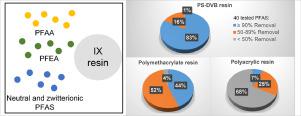Water Research ( IF 11.4 ) Pub Date : 2021-10-21 , DOI: 10.1016/j.watres.2021.117781 Yen-Ling Liu 1 , Mei Sun 1

|
Ion exchange (IX) is a promising technology to remove legacy anionic per- and polyfluoroalkyl substances (PFAS) from water. As increasing numbers of per- and polyfluoroalkyl ether acids (PFEA) and other emerging PFAS were detected in the environment, it is necessary to understand how well IX resins remove these emerging PFAS for drinking water treatment. In this study, nine commercially available IX resins were tested to treat a drinking water source spiked with 40 legacy and emerging PFAS at 600 ng/L, including PFEA, perfluoroalkyl carboxylic and sulfonic acids, fluorotelomer sulfonic acids, perfluoroalkane sulfonamides, perfluoroalkane sulfonamidoacetic acids, and zwitterionic species. With limited contact time (15 min), PFAS properties such as the fluorinated chain length, charge, and functional groups all affected PFAS adsorption to resins. However, the impact of PFAS properties on PFAS removal became less pronounced when the contact time increased beyond 2 h, while the resin polymer matrix became the critical factor for PFAS removal. All five tested polystyrene-divinylbenzene (PS-DVB) resins achieved more than 90% removal in 24 h of 35 PFAS compounds, while polymethacrylate and polyacrylic resins achieved >90% removal for less than half of the compounds. Regenerating PS-DVB resin was investigated using different salt species, regenerant pH, brine concentrations, and methanol contents. Sodium chloride and ammonium chloride were found the best brines for regenerating the tested resins. Increasing brine concentrations enhanced the regeneration efficiency, especially for short-chain PFAS. Using simple salt regenerants, up to 94% of selected short-chain PFAS was released from resins designed for general water treatment, but no meaningful regeneration was achieved for long-chain PFAS or PFAS-specific resins when the organic solvent content was less than 20%.
中文翻译:

离子交换去除和树脂再生以处理饮用水中的全氟和多氟烷基醚酸和其他新出现的 PFAS
离子交换 (IX) 是一种很有前途的技术,可以从水中去除遗留的阴离子全氟和多氟烷基物质 (PFAS)。随着在环境中检测到越来越多的全氟和多氟烷基醚酸 (PFEA) 以及其他新出现的 PFAS,有必要了解 IX 树脂在饮用水处理中去除这些新出现的 PFAS 的效果如何。在本研究中,测试了 9 种市售 IX 树脂处理饮用水源,其中 40 种遗留和新兴 PFAS 的浓度为 600 ng/L,包括 PFEA、全氟烷基羧酸和磺酸、含氟调聚物磺酸、全氟烷烃磺酰胺、全氟烷烃磺酰氨基乙酸、和两性离子物种。在有限的接触时间(15 分钟)下,PFAS 的性质,如氟化链长、电荷和官能团,都会影响 PFAS 对树脂的吸附。然而,当接触时间增加超过 2 小时时,PFAS 特性对 PFAS 去除的影响变得不那么明显,而树脂聚合物基质成为去除 PFAS 的关键因素。所有五种测试的聚苯乙烯-二乙烯基苯 (PS-DVB) 树脂在 24 小时内对 35 种 PFAS 化合物的去除率均超过 90%,而聚甲基丙烯酸酯和聚丙烯酸树脂对不到一半的化合物的去除率超过 90%。使用不同的盐类、再生剂 pH 值、盐水浓度和甲醇含量研究了再生 PS-DVB 树脂。发现氯化钠和氯化铵是再生测试树脂的最佳盐水。增加盐水浓度可提高再生效率,尤其是对于短链 PFAS。使用简单的盐再生剂,











































 京公网安备 11010802027423号
京公网安备 11010802027423号